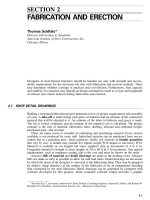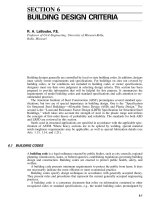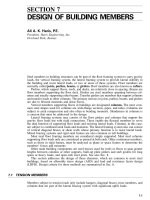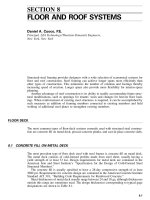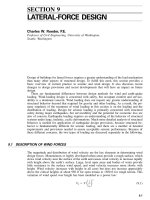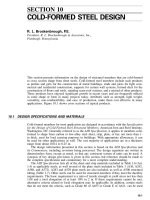Sổ tay các mác thép khuôn mẫu Bohler hay nhất
Bạn đang xem bản rút gọn của tài liệu. Xem và tải ngay bản đầy đủ của tài liệu tại đây (5.06 MB, 48 trang )
YOUR PARTNER FOR
HIGH SPEED STEELS, TOOL STEELS
AND SPECIAL MATERIALS
FOR THE WORLD’S
TOP PERFORMERS
METALLURGICAL
KNOW-HOW SINCE 1870.
EMIL BÖHLER
ALBERT BÖHLER
For generations worldwide customers appreciate the highest
steel quality from BÖHLER.
We produce SPECIAL STEEL FOR THE WORLD’S TOP
PERFORMERS and our standard is to provide the best
solution every time – whether in manufacturing technology,
materials development, or customer service.
With an international sales and service network we are always
close to our customers – worldwide.
WELCOME TO BÖHLER.
2
It is impossible to imagine our modern world without
special steel. This material will continue to drive success
and growth in crucial branches of industry, both in direct
components and in the tools used to shape them.
3
FOR THE WORLD’S BEST STEEL GRADES
Flow of material
Melting
VOD
Ingot casting
(electrodes, ingots)
ESR
Atomising
Filling capsules
EAF 50t
HCC
PESR
Ladle furnace
VID 13t
AOD Converter
Welding
HIP
VIM
VAR
Melting
Secondary metallurgy
Casting / Melting
Remelting
Powder metallurgy
4
Turning
Grinding
Stock
52 MN Press
Milling
Rotary forging machine
Peeling
Multiline
Rolling Mill
Wire
forming
Shipment
Cogging Mill
Rolling and Forging
5
Precision
forming
Heat Treatment
Machining
Testing
Dispatch
BÖHLER SPECIALTIES
What do we stand for?
Powder metallurgical steels
We develop, produce and deliver high speed steels,
tool steels and special materials worldwide, to provide
our customers with customized solutions.
Special materials subjected to vacuum refining or melting
during at least one stage of manufacture.
Plastic mould steels in ESR quality
HIGH SPEED
STEEL
POWDER
METALLURGY
COLD WORK
TOOL STEEL
HOT WORK
TOOL STEEL
PLASTIC MOULD
STEEL
AMPO
AEROSPACE
AUTOMOTIVE
OIL, GAS & CPI
POWER
GENERATION
SEMI FINISHED
PRODUCTS
OPEN DIE FORGE
Cold work tool steels in ESR quality
High speed steels in ESR quality
Hot work tool steels in ESR quality with special heat treatment
Hot work tool steels in conventional quality with special
heat treatment
Special property and/or achievement characteristics
Bars hardened and tempered
Additive Manufacturing Powder
6
PRODUCT RANGE
Materials
High speed steels
Tool steels
■ Cold work tool steels
■ Hot work tool steels
■ Plastic mould steels
Special materials
Special constructional steels
■ Stainless steels
■ Creep resisting steels
■ Heat resisting steels
■ Valve steels
■ Steels with special physical properties
■ Steels for particular applications
■ Ni base alloys
■
Products
BAR STEEL rolled
round:
12.5 – 150mm
square:
15 – 150mm
flat: width thickness
15 – 60mm
5 – 41mm
60 – 200mm
5 – 86mm
100 – 300mm
15 – 80mm
ROLLED WIRE
rolled (dia.)
5.0 – 13.5mm
drawn (wire, bar steel):
0.6 – 13.3 mm Ø
round (bar steel):
2.0 – 28.0 mm Ø
peeled (wire):
4.5 – 13.0 mm Ø
BHT (hardened and tempered) bar steel:
3.0 – 20.0mm Ø
flat or profiled wire:
0.5 – 40.0 mm2
BAR STEEL forged
round:
101 –1150mm
square:
110 –1150mm
flat: width
thickness
107
70 mm minimum
1600
1150 mm maximum
Ratio width/thickness maximum 10:1
7
BAR STEEL pre-machined
IBO ECOMAX 12.5 – 315 mm
(on request up to 900 mm)
BRIGHT STEEL
BRIGHT STEELground and polished
ECOBLANK peeled and polished
ECOFINISHband ground
Surface finish
black (abrasive blasted); pickled; machined (turned, peeled,
polished h12 – h9); ground – polished
Forgings
Open-die forgings of a gross weight of up to 45t:
unmachined, premachined, machined ready for mounting.
Machining of rolled, forged an cast components on
state-of-the-art machines.
Industries
Automotive industry, aviation industry, turbine construction,
toolmaking industry, general mechanical engineering, offshore
industry, energy engineering, medical technology
COLD WORK TOOL STEELS
3 QUALITY LEVELS – 3 TECHNOLOGIES
Conventional Manufacture
Ingot casted cold work
tool steel
The conventional steel
quality for standard tooling
applications.
Microstructure of conventional 12% Cr steel
ESR / PESR Manufacture
Improved service life due to:
■ Least possible inclusion content
■ Lower micro and macro segregation
■ Good homogeneity and a higher degree of purity
■ Homogeneous structure throughout the
entire cross-section and bar length
■ Producing larger bar
dimensions at a constant
carbide distribution
■ Uniform size change
■ Broad range of application
owing to a high degree of
toughness
Microstructure of an 8% Cr steel in ESR quality
Powder Metallurgical Manufacture
For the highest demands:
Finest carbide distribution
■ Highest metallurgical purity
■ Segregation free high
performance steel
■ Isotropic properties
■ Maximum wear resistance
with a simultaneously
higher toughness
■ High degree of hardness
■ Very good dimensional
stability
■ High compressive strength
■ Good polishability
■
Atomisation
Melting
Capsule
filling
Microstructure PM materials
8
HARD & TOUGH
The reason for using quality tool materials is obvious, as the
material amount of a high performance tool is often only 5% of
the total value of a tool, yet it extends the lifetime of tools
many times. In a word, it’s a direct commercial advantage in
production.
Property profile of BÖHLER cold work steels according to manufacturing technologies
S290
Powder Metallurgy
ESR
K390
Conventional
Abrasive wear resistance
S390
K490
S690
S600
K890
K360
K340
K110
K100
K460
W360
K455
K305
K353
K720
K329
K600
Toughness, ductility
9
K340
BÖHLER K340 ISODUR is a universal cold work tool
steel with which you’ll be making money – and not just when
blanking coins, but also when blanking, cutting, cold
rolling, extruding, deep drawing, bending.
In applications where materials with good wear resistance and
compressive strength coupled with excellent toughness are
required, BÖHLER K340 ISODUR has proved itself to be the
all-rounder among tool steels.
Advantages compared to ledeburitic 12% Cr-steels and
conventional 8% Cr-steels
■ Homogeneous structure throughout the entire cross-section
and length
■ Production of bars with greater diameters and a good
distribution of carbides
■ Uniform, solely minor dimensional changes
■ High toughness providing a wider scope of application
■ Increased compressive strength, a particular advantage for
critical tools
■ Improved machinability due to the homogeneous structure
Reasons why BÖHLER K340 ISODUR is so cost-efficient
8% Cr-steel with a modified chemical composition
■ High toughness and outstanding compressive strength
■ Excellent adhesive wear resistance thanks to special alloy additions
■ High abrasive wear resistance
■ Very good resistance to tempering
■ Secondary-hardening cold work tool steel with good
dimensional stability
■ Outstanding EDM machinability
■ Very well suited to salt-bath, gas and plasma nitriding
■ Can be PVD coated well
■ Well suited to vacuum hardening
■ Thanks to the chemical composition and the manufacturing process, this steel has finer and more evenly distributed carbides
than ledeburitic 12% Cr-steels (AISI D2) and conventional 8%
Cr-steels. This gives the steel its improved toughness properties.
■
Application fields
Forming and punching tools e.g. dies and punches, cold
working tools e.g. tools for deep drawing or extrusion, coining
tools, bending tools, thread rolling tools, industrial knives,
machine components (e.g. guide rails)
Toughness (unnotched)
Longitudinal Ø 148 mm / 60 HRc
Impact energy (J)
20
15
10
5
0
C
R1/2R
C
R1/2R
K360
C
K340
Adhesive wear resistance
R1/2R
D2
C
Abrasive wear resistance
61 HRc
61 HRc
25
12
10
20
Material loss (1/g)
Adhesive wear resistance (1/g)
R1/2R
M2
15
10
5
8
6
4
2
0
K360
1.2379/D2
0
K340
K360
1.2379/D2
K340
10
K490
Innovation
BÖHLER’s new cold work tool steel K490 MICROCLEAN
closes the gap in the material demands between wear
resistance and the desired toughness on a very high level.
Flexibility
BÖHLER K490 MICROCLEAN’s balanced properties can be
made use of in a wide range of applications, making it a real
PM all-rounder for cold work tool steel applications.
Blanking and punching industry
Cutting tools (dies, punches) for normal and
precision blanking
■ Cutting rolls
■
A further advantage of this powder metallurgical cold work
tool steel, being produced in a plant of the newest generation,
lies in the good machinability and the high flexibility of its heat
treatment, which allows variable heat treatment cycles without
affecting the mechanical properties.
Cost-Efficiency
These excellent properties guarantee a risk-free, more flexible
and faster – that is economically efficient – tool manufacture.
Versatility
BÖHLER K490 MICROCLEAN is a greatly improved and
more efficient cold work tool steel compared with other commonly used PM steels such as M4 or PM23. Toughness is
more than doubled with a similar wear resistance.
Toughness (unnotched)
Cold forming applications
Extrusion tooling (cold and warm forming)
■ Drawing and deep-drawing tools
■ Stamping tools
■ Thread rolling tools
■ Cold rolls for multiple roller stands
■ Cold pilger rolling mandrels
■ Compression moulding dies for the ceramics and
pharmaceutical industries
■ Compression moulding dies for the processing of sintered parts
■
■
Industrial knives
■
Plastic processing industry
Abrasive wear resistance
62 HRc
good
Standardised abrasive
wear resistance (g –1)
Impact energy (J)
80
60
40
20
0
1.2379/D2
Samples taken from a rolled steel bar in longitudinal direction, heat treated at a
cooling rate of: λ ≤ 0,5
Primary material size: rund / round 35 mm
Sample size: 10 x 7 x 55 mm
Heat treatment parameters for:
BÖHLER K490 MICROCLEAN: 1080 °C, 3 x 2 h, 560 °C
1.2379/D2: 1070 °C, 3 x 2 h, 520 °C
Saves time and money
Speed is vital in component manufacture. Process time from
prototype to finished tooling is drastically reduced. Tools of
complicated design and high quality can be produced quickly
and efficiently.
Benefits
■ Shorter and cheaper production processes due to a flexible
heat treatment and an excellent hard machinability
■ Higher tool life due to the excellent and stable mechanical
properties
11
1,5
1
0,5
0
bad
K490
62 HRc
1.2379/D2
K490
Determined by the Rubber-Wheel-Dry-Sand test according to ASTM G65
Samples taken from a of rolled steel bar in lateral direction, center
Primary material size: rund / round 70 mm
Sample size: 60 x 25 x 8 mm, Ra < 0,8 µm
Heat treatment parameters for:
BÖHLER K490 MICROCLEAN: 1080 °C, 3 x 2 h, 560 °C
1.2379/D2: 1070 °C, 3 x 2 h, 510 °C
Properties
High hardness (64 HRc)
■ Very good toughness
■ High abrasive and adhesive wear resistance
■ Excellent hard machinability
■ High compressive strength
■ Heat treatment together with common cold work steels
(1.2379, D2) at hardening temperatures from 1030 to
1080 °C possible
■ Stable mechanical properties
■
Materials used for cutting, punching and blanking of high-strength and ultrahigh-strength sheets
Tool steels – sheet materials
Cast iron tools
50
K110
K340
K390
ULC
(IF)
K490
S390
LC
40
K340
Fracture strain A80 (%)
HSIF
Isotrop
BH
30
CMn
TRIP
HSLA
20
DP
PM
10
0
0
PHS
22MnB5
200 400 600 800 10001200140016001800
Tensile strength (MPa)
ULC Ultra low carbon steels
LC
Low carbon steels
HSIF High strength IF steels
Isotrop Isotropic steels
BH
HSLA
TRIP
CMn
Bake-hardening steels
High-strength low alloyed steels
Transformation induced plasticity steels
Carbon manganese steels
DP
Dual phase steels
PM Partial martensitic steels
PHS Presshardened steels
12
Evaluation of material properties in blanking and cutting applications (please note: The comparison is strongly dependent on the
heat treatment conditions and applicable for the brands within this table only):
BOHLER grade
13
Wear resistance
abrasive
adhesive
Toughness
Compressive
strength
Dimensional stability
in heat treatment
K100
★★★
★★
★
★★
★★
K110
★★★
★★
★
★★
★★
K305
★
★
★★★★
★
★
K340
★★★
★★★★
★★★
★★★★
★★★
K353
★★★
★★★
★★★★★
★★
★★
K360
★★★★
★★★★
★★
★★★★
★★★
K390
★★★★★
★★★★★
★★★★
★★★★★
★★★★
K455
★
★
★★★★★
★
★
K490
★★★★
★★★★
★★★★★
★★★
★★★★
K600
★
★
★★★★★
★
★
K890
★★★
★★★
★★★★★
★★★★
★★★★
S600
★★★
★★
★★★
★★★
★★★
S290
★★★★★
★★★★★
★
★★★★★
★★★★★
S390
★★★★
★★★★
★★★★
★★★
★★★★
S690
★★
★★★
★★★★★
★★★
★★★
W360
★
★
★★★★★★
★
★
For specific applications and selection of proper material and working hardness please refer to our technical sales staff.
HOT WORK TOOL STEELS
Tool load
Hot work tool steels applied in hot forming processes such as
die casting, forging or extrusion may be damaged on multiple
and complex occasions. Damages may arise by collective
stress factors combining high mechanical strengths, high temperatures and temperature gradients, whereas the individual
stress factors dependent on process type and processing
exert variably strong effects on the material. Material hardness, material strength, toughness, ductility and thermal
conductivity are vital hot work tool steel properties when it
comes to damage mechanisms to be avoided or delayed.
As the leading producer of tool steels worldwide BÖHLER is
focused on offering solutions for the demanding requirements
on hot working tool steels.
3 qualities for special applications:
■
Hot wear resistance, hot toughness, hot strength, retention
of hardness, thermal shock resistance as well as thermal
conductivity are characterized not only by the compostion of
the hot work tool steel but are metallurgical features regulated
during the melting and re-melting process.
Our experience and on-going research lead to the continuous
improvement of the metallurgical properties by further developments in the melting and remelting process of hot work
tool steels and their heat treatment.
■
■
■
■
■
Conventional hot work tool steels
Special heat treated
Hot work tool steels, ESR quality
Special heat treated
Hot work tool steels, VAR quality
Special heat treated
Production routes for BÖHLER hot work tool steels
Melting
Secondary Metallurgy
Casting
Ladle Furnace
Remelting
Homogenising
ESR
Special Heat
Treatment
Ingot Casting
Forging or Rolling
Vacuum Treatment
VAR
14
NADCA material approval
BÖHLER W300 ISOBLOC
BÖHLER W302 ISOBLOC
BÖHLER W350 ISOBLOC
BÖHLER W400 VMR
BÖHLER W403 VMR
DIE CASTING
Heat treatment
In order to achieve high toughness in tools, the cooling rate
from the hardening temperature is of major importance.
Cooling rate is primarily dependent on the tool size.
With increasing tool thickness, resulting in a reduced quenching rate, a change of microstructure occurs, leading to a
significant decrease of toughness.
The quality of a tool made of hot work tool steel is defined by
its mechanic-technological properties. It largely depends on
the metal alloy’s chemical composition, on the tool material’s
production process (electro slag remelting, vacuum remelting,
forging and annealing technologies) and finally on the tool’s heat
treatment.
Damage mechanisms
Tool steel properties
Thermal fatigue
crack networks
Hardness
Strength
Erosion
Toughness
Gross cracking
Ductility
Stress cracks
Thermal conductivity
Chemical attack
Cooling chart
Toughness comparison
DIN 1.2343 / H11
DIN 1.2343 / H11
18
1100
16
Pearlite
700
500
Bainite
300
14
12
8
6
4
2
0
0
1 10 100 1000 10000 100000
Time (s)
800 mm
500 mm
2
1 Die casting die edge
2 Die casting die core
3 Toughness sample Charpy-V
10 x 10 mm
3
55 mm
– 57%
10
100
1
15
Toughness Charpy-V (J)
Temperature (°C)
900
1 Fast quenched
2 Slowly quenched
– 39%
1
2
44 HRc
1
2
47 HRc
W350
A balanced alloy composition ensuring high toughness even
in large tools and an improved thermal stability opts for an
optimal hardness/strength-toughness/ductility ratio (elongation
after fracture and percentage reduction of area after fracture)
tailor-fit to every application.
A pressurized remelting process (pressure ESR) coupled with
optimized forging technology in three dimensions guarantees
a high degree of homogeneity of the mircrostructure and
the material properties. A high degree of purity can also be
realized.
Hot work steel BÖHLER W350 ISOBLOC is characterized by
a significantly higher level of toughness for a fast and a slow
cooling from the hardening temperature compared with standard materials DIN 1.2343 and 1.2367.
Toughness comparison
30
1 Fast quenched
2 Slowly quenched
25
Charpy-V (J)
With the development of W350 ISOBLOC, BÖHLER Edelstahl
allows large tool sizes for complex loads in hot forming and for
effects of heat treating.
20
15
10
5
1
2
1
2
1
2
0
DIN 1.2343
ESR / H11
44 HRc
DIN 1.2367
ESR
44 HRc
W350
44 HRc
The reduced cooling velocity leads to a significant decrease
of toughness. If the hardness is increased, the decrease in
toughness is even higher.
16
FORGING
The demands on forging die steels are primarily determined
by the respective forging process but also by the shape and
properties of the material the components are to be made of.
As a result, the demands on the die steel are derived, such as
High thermal shock resistance
High hot strength
■ High retention of hardness
■ Exceptional high hot toughness
■ High hot wear resistance
■ Improved thermal conductivity
■ Good heat checking resistance
■
■
Drop forging
Rapid forging
Drop forging is carried out by impacting material with
a hammer or by applying a great amount of pressure with
a forging press or forging machine.
A fully automatic multi-stage press is forging equipment that
produces even the most difficult shapes from materials
hard to deform in several stages of deformation. This
equipment mostly produces rotation symmetric parts.
Heating the slugs, feeding, shearing and deforming take place
completely automatically.
When forging with a hammer the forging piece is only in
contact with the die for a short period of time. Due to this,
the die has to withstand lower temperatures. However, the
mechanical stress is high. Thus, it is quite important for
the hot work tool steel used to have very good toughness
properties.
Compared with that, the contact during forging pressing
occurs over a longer period of time, which then causes a
higher temperature strain on the tool. Thus, in such a
case hot work tool steels with a chromium-molybdenum base
are used, which are singled out as having good tempering
resistance, high temperature strength, hot wear resistance,
and hot toughness.
Requirement profile
Wear resistance
Retention of hardness
High temperature strength
Heat checking resistance
High temperature toughness
17
Semi hot forging
The term semi hot forging refers to a deformation process in
which the workpiece is preheated to such a point that
permanent strain hardening occurs under the given deformation conditions. This definition means that the material is
deformed below the recrystallization temperature, yet the term
is also used for temperatures occurring above this. In practice
this is understood to be the deformation of steel in the temperature range of 650 to approx. 950 °C. These temperatures
lie significantly below the conventional forging temperatures of
1100 – 1250 °C.
Drop forging with hammer
Drop forging with press
Semi hot forging
★★★★★
★★
★★★
★
★★★★
★★★★★
★★★★
★★★
★★
★★★
★★★★★
★★★
★★★★
★
★★
W360
BÖHLER W360 ISOBLOC was developed as a tool steel
for dies and punches in semi-hot and hot forging. It owes its
excellent properties to a patented alloying concept and the
electroslag remelting (ESR) process. This grade can be used
for a variety of applications where hardness and toughness
are required.
Toughness
The toughness of hot work tool steels is one of the most
important properties for safety against fracture and increased
resistance to heat-checking and thermal shock. High hardness is usually associated with low toughness. This is not the
case for W360 ISOBLOC.
Properties
■ High hardness (recommended in use: 52 – 57 HRc)
■ Exceptional toughness
■ High temper resistance
■ Good thermal conductivity
■ Can be cooled with water
■ Homogeneous microstructure
Hot hardness
Alongside the outstanding toughness, W360 ISOBLOC is distinguished by its high thermal stability. This is reflected in the
high hot hardness and the stability of the material under thermal
loading. These properties, combined in W360 ISOBLOC, ensure a high resistance to thermal fatigue and catastrophic failure.
Toughness (unnotched)
Applications and uses
■ Dies and punches in warm and hot forging
■ Tooling for high speed presses
■ Toughness-critical cold work applications
■ Extrusion tooling, e.g. dies
■ Core pins and inserts in die-casting dies
■ Specific applications in the plastic processing sector
20 °C
Unnotched impact energy (J)
300
250
200
150
100
50
57 HRc
51 HRc
0
1.2367 ESU
W360
BÖHLER W360 ISOBLOC has a significantly higher toughness than
1.2367 ESU – at a higher hardness.
W360 57 HRc
450
W360 51 HRc
400
350
60
T = 600 °C
1.2885 51 HRc
1.2367 51 HRc
300
Hardness
55
50
35
45
30
25
20
15
10
Hardness (HRc)
500
Toughness at 500 °C
Notched impact energy Charpy-U (°C)
Hot hardness HV
Hot hardness
Toughness
40
35
5
1000
30
0
520540560580600
620 °C
Anlasstemperatur / Tempering temperature
At 51 HRc, BÖHLER W360 ISOBLOC has a higher hot hardness than
1.2885 and 1.2367. If the hardness of BÖHLER W360 ISOBLOC is increased
to 57 HRc, then the result is a further increase in the hot hardness.
Looking at the toughness over tempering temperature (hardness) it can be
seen that the toughness of BÖHLER W360 ISOBLOC is almost constant from
51 to 57 HRc.
250
10
100
Time at 600 °C in minutes
18
ROD EXTRUSION
Rod extrusion
Highly stressed extrusion tools require a high degree of metallurgical cleanliness, excellent homogeneity and best toughness
at high working hardness. These requirements are met by
selected BÖHLER hot work tool steels for the extrusion industry.
Increased heat checking resistance
Reduced hot wear
■ Increased hot strength
■ Higher working hardness
and therefore
■ Longer tool life
■
■
That increases the productivity, lowers the unit costs and
makes the final product more competitive.
Requirement profile
Wear resistance
Hot hardness
High temperature strength
Creep resistance
Heat checking resistance
Compressive strength
High temperature toughness
Mantle
Liner holder
Liner
Stem
★
★★★
★★★
★★★★★
★
★
★★★
★
★★★
★★★★
★★★★★
★
★★★
★
★★★★
★★★★
★★★★
★★★
★★★★
★★
★★★
★★
★★★★
★★★
★
★
★★★★★
★★
Evaluation of material properties
BOHLER grade
High temperature
strength
High temperature
toughness
High temperature
wear resistance
Machinability
W300
★★
★★★
★★
★★★★★
W300
★★
★★★★
★★
★★★★★
W302
★★★
★★★
★★★
★★★★★
W302
★★★
★★★★
★★★
★★★★★
W303
★★★★
★★★
★★★★
★★★★★
W320
★★★
★★
★★★
★★★★★
W321
★★★★
★★
★★★★
★★★★★
W350
★★★
★★★★★
★★★★
★★★★★
W360
★★★★★
★★★★
★★★★★
★★★★★
W400
★★
★★★★★
★★
★★★★
W403
★★★★
★★★★
★★★★
★★★★
W500
★
★★★
★
★★★
W720
Maraging steels (ageing temperature about 480 °C), in this form not comparable with the heat treatable steels.
W722
For specific applications and selection of proper material and working hardness please refer to our technical sales staff.
19
PLASTIC MOULD STEELS
To meet the highest demands BÖHLER plastic mould steels
are the ultimate solution to any application in the manufacture
of mould and machine parts, meeting the highest expectations of users as regards shape, function, aesthetics, product
quality and durability. BÖHLER steels are of a guaranteed
consistent quality and developed for the most stringent future
demands.
As a mould maker you certainly know of all the demands a
product should meet. BÖHLER, therefore, offers you competent material consulting on the steel, it’s properties and the
heat treatment to meet your requirements best.
20
M268
BÖHLER M268 VMR is a hardened and tempered plastic
mould steel with excellent cleanliness for best polishability.
The hardness is constant over the entire cross-section of the
steel block, even at large sizes, due to the addition of nickel.
Thermal conductivity
Thermal conductivity (W/m.K)
37
M268
Applications
Moulds for plastics processing, components for general
mechanical engineering and tool manufacture where highest
polishability and fatigue strength are required.
Condition of supply
Hardened and tempered to 350 – 400 BHN, High-hard.
Generally, no heat treatment is required. If heat treatment is
carried out, e.g. to obtain an increase in strength, the instructions given in this brochure should be observed.
34
31
1.2343 (H11)
28
Mirror Polishability
The excellent cleanliness of BÖHLER M268 VMR, achieved
by the vacuum remelting technology, has a positive impact on
the polishability of large moulds and complex geometries.
1.2344 (H13)
25
Optimizing of cycle times
The high thermal conductivity guarantees a reduction of cycle
time and increases the efficiency of the production process.
22
0 100200300400
Temperature (°C)
Further advantages of our hardened and tempered
plastic mould steel BÖHLER M268 VMR:
■ Suitable for all nitriding processes to improve wear resistance
■ Can be hard chromium plated. Suitable for every type of
galvanic surface treatment used to optimize hardness and
corrosion resistance
■ Suitable for PVD coating, providing excellent adhesion
conditions for the TiN-layer
■ The material can be induction-hardened if necessary
■ Suitable for photo-etching
Higher quality
Advantages and benefits
The economic and technological advantages of BÖHLER
M268 VMR at a glance:
Reliability
Uniformly high strength and toughness, even at larger sizes
High through hardenability
■ Excellent thermal conductivity
■
■
Efficient tool making
No heat treatment required
Excellent, high polishability
■ Good texturing properties
■ Good electrical discharge machining properties
■
■
The material does not require heat treatment, reducing
the risk of errors
■ The good toughness decreases the risk of cracking
during service
■
= Improved productivity and cost reduction
21
M303
The new classic
BÖHLER M303 EXTRA is a corrosion resistant martensitic
chromium steel, offering excellent toughness, corrosion
and wear resistance. It is characterized by improved
machinability and polishability.
And what is special about it – BÖHLER M303 EXTRA was
developed for improved homogeneity ensuring excellent
usage properties. And the outcome is – compared to
1.2316 – the prevention of delta ferrite in the matrix.
M303
Hardened and tempered:
290 – 330 HB
M303
Hardened and tempered:
350 – 390 HB
HIGH HARD
This material is also offered by BÖHLER in the ”High-Hard“version, with a significantly better wear resistance.
Toughness (unnotched)
Unnotched impact energy (J)
250
200
150
100
50
Centre
Surface
Centre
Surface
Centre
Surface
Centre
Surface
0
1.2316
30 HRc
1.2316
40 HRc
M303
M303
HIGH HARD
30 HRc
Comparisons made with 1.2316 show that BÖHLER M303
EXTRA has a more regular and improved toughness over the
40 HRc
block zones thus ensuring a better fracture resistance and
avoiding unexpected downtimes.
Surface comparison
Surface profile
Surface profile
Homogeneous
surface structure
Soft δ-ferrite phase
Coarse hard phase
1.2316
M303
M303
HIGH HARD
In the case of 1.2316, the hard carbide phases being
imbedded in the soft delta ferrite zone, are causing an
irregular polish. In contrast BÖHLER M303 EXTRA
shows regular polish.
22
M333
A product is only as good as the surface finish of the tool in
which the product is formed. Particularly in the field of mirrored finishes no mistakes are condoned. Irregularities on the
surface are immediately visible. Until now it has been particularly time-consuming and costly for toolmakers to produce
inserts with a mirrored finish. That effort was coupled with the
fact that the finished results were less than satisfactory.
Advantage of BÖHLER M333 ISOPLAST at a glance:
■ Optimum polishability for mirror finish
■ Improved thermal conductivity
■ Exceptional toughness and hardness
■ Very good corrosion resistance
Quick high-grade polish in no time at all
(tests from the lab and in action)
Shorter cycle time and higher productivity due to improved
thermal conductivity. Your tool stays ”cool“.
very good
30
Thermal conductivity (W/m.K)
Polishability for mirror finish (evaluation)
1.2343 ESR
1.2083
ESR
1.4028
VAR
M333
Mean values of the findings of several Austrian and German companies regarding time and quality after mechanical and handpolishing of 6 samples of each
material.
23
M333
25
20
1.2083 ESR
15
0 100200 300400 500
Testing temperature (°C)
Source: Materials Center Leoben Forschung GmbH, ÖGI
M390
BÖHLER M390 MICROCLEAN is a martensitic chromium
steel produced with powder metallurgy. Due to its alloying
concept this steel offers extremely high wear resistance
and high corrosion resistance – the perfect combination for
best application properties.
Extremely high wear resistance
High corrosion resistance
■ Excellent grindability
■ High mirrorfinish polishability
■ High toughness
■ Minimum dimensional changes
■ Better resistance to vibrations and mechanical shocks
■
■
Field of applications
■ Mould inserts for the production of CDs and DVDs
■ Moulds for the processing of chemically aggressive plastics
containing highly abrasive fillers
■ Moulds for the processing of duroplasts
■ Moulds for the production of chips for the electronics
industry
■ Screws for injection moulding machines
■ Non return valves
■ Linings for injection moulding cylinders
enable
Long and consistant tool life
Reproducibility of production processes
■ High precision components
■
■
Benefit
■
■
Increased productivity
Reduced unit costs
24
BOHLER grade
Wear
resistance
Toughness
Polishability
Machinabilty
in as-supplied
condition
Throughhardenability
Grindability
Supplied
condition
M200
★★
★
★
★★★
★
★
V
290 – 330 HB
M238
★★
★★
★★
★
★★★
★★★
V
290 – 330 HB
M238
★★★
★★
★★★
★
★★★
★★★
V
approx. 40 HRc
(HIGH HARD)
M268
★★★
★★★
★★★★
★
★★★
★★★
V
approx. 40 HRc
(HIGH HARD)
M261
★★
★
★
★★
★★
★
LA
approx. 40 HRc
HIGH HARD
BOHLER grade
Corrosion
resistance
Wear
resistance
Toughness
Polishability
Machinabilty
in as-supplied
condition
Supplied
condition
Heat treated, corrosion resistant steels *
M303
★★★
★★
★★
★★★
★
V
approx. 1000 N/mm2
M303
★★★
★★★
★★
★★★
★
V
approx. 40 HRc
M314
★★
★
★
★★
★★
V
approx. 1000 N/mm2
M315
★★
★
★
★
★★★
V
approx. 1000 N/mm2
N700
★★★
★★
★★★
★★★
★
V
approx. 1500 N/mm2
HIGH HARD
Hardenable, corrosion resistant steels *
M310
★★
★★
★
★★
★★★
W
max. 225 HB
M333
★★
★★
★★★
★★★
★★★
W
max. 220 HB
M340
★★★
★★★
★
★
★★
W
max. 260 HB
M390
★★★
★★★
★★
★★★
★
W
max. 280 HB
N685
★
★★★
★
★
★
W
max. 265 HB
Evaluation of material properties in plastic moulding applications (Please note: The comparison is applicable for the brands of each
group only): For particular requirements in terms of corrosion resistance, wear resistance or dimensional stability please consult
our technical sales staff.
W Soft annealed
V Hardened and tempered to obtain good mechanical properties
25
LA Solution annealed and precipitation hardened
* The profiles given are characteristic of each group of steels.

